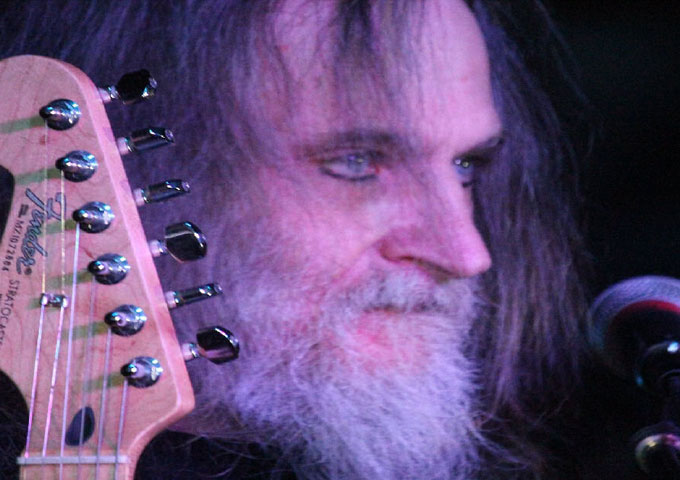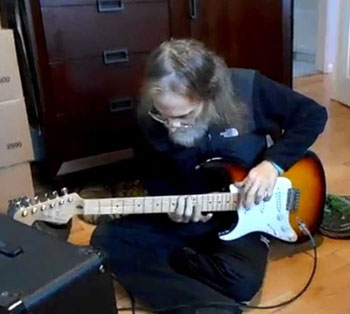
Steve Lieberman’s Boundary Pushing Symphonic Thrash!
The first composers to insist on the aesthetic necessity of noise in music were the Italian Futurists at the start of the 20th century, who made and performed with new noise-producing instruments. Forward to the 21st century, and there are only a handful of artists using extremes of massive sonic slabs produced by a whole gamut of electronic and acoustic sounds – among them Steven Lieberman-Marcus (the Gangsta Rabbi and The King of Jewish Punk). And when you’re confronted by this music, it’s an astonishing and strange experience. I have followed Lieberman’s music for quite a few years now, and I don’t remember hearing any other musician during my lifetime take conventional music standards so far into the realms of ‘noise’, as he does. Hardcore Punk or Thrash Metal don’t even come close to describing the anti-establishment boundaries Steve has long surpassed in his musical quest. In the past he has dissected and reconstructed classic rock works by The Who and Jethro Tull, and just recently he has turned his attentions to classic and opera music.
 Now he has released “EXCERPTS-LA SYMPHONIE-THRASHE DU PROFESSEUR-JUIF-REBELE (#37/75) (2019/3470)”, which essentially is his first punk symphony. Here, the terminally ill Steve Lieberman, wrote, orchestrated, arranged, recorded, sang, and performed 18 instruments – including guitar, bass, melodica, flutes, trombones, trumpet, clarinet, talabard and euphonium – from his dying days in the Hospice. The whole symphony took him 7 months to complete, and runs for 5 hours 36 minutes. As a note of interest, Steve dedicated this epic work to the memory of Linda Lieberman (1957-2019), his wife of 27 years.
Now he has released “EXCERPTS-LA SYMPHONIE-THRASHE DU PROFESSEUR-JUIF-REBELE (#37/75) (2019/3470)”, which essentially is his first punk symphony. Here, the terminally ill Steve Lieberman, wrote, orchestrated, arranged, recorded, sang, and performed 18 instruments – including guitar, bass, melodica, flutes, trombones, trumpet, clarinet, talabard and euphonium – from his dying days in the Hospice. The whole symphony took him 7 months to complete, and runs for 5 hours 36 minutes. As a note of interest, Steve dedicated this epic work to the memory of Linda Lieberman (1957-2019), his wife of 27 years.
The symphony extracts are divided into 15 musical pieces, all titled as exuberantly as the music they represent. Attempting to justifiably review this album track by track would be a daunting task even for me, let alone the uninitiated in Steve’s unique craft, and it is easily explained. Steve’s music is bathed in relentless cacophony – the extreme execution of musical passages, both in volume and timbre, which to many, results in what they would call ‘noise’.
Most people have a ‘melody + rhythm = music’ bias. They know about timbre and are able to pay attention to the way things sound, but without a clear and evident melody nearby, timbre amounts to practically nothing for them. The problem is simple to understand, ‘noise’ seems to require relentlessly focused active listening to appreciate the nuances, or it degenerates into…noise.
In his book ‘Noise, Water, Meat: A History of sounds in the arts’, Douglas Kahn brings together a series of reflections on ‘noise’ outlines, and traces a history of sound in the arts, from modernism to avant-garde. Kahn builds his interpretation on the basis of a communicational split: sound, meaning, significant noise.
For Kahn, noise is too important and significant to be just ‘noise’. In this case two aspects are relevant. First, the idea that noise is not a thing in itself, but the result of a relationship. In other words: what may be considered noise in one context, may not be in another.
During the twentieth century there is a tendency to put the idea of sound side by side with the idea of tone. While the former takes the sound as an acoustic phenomenon whose characteristics are sensory perceived, the latter is based on an abstract representation of the phenomenon, called the ‘note’.
 Again, no one else I can think of understands this concept better than Steve Lieberman. Hence he is able to take it to its logical extreme on “EXCERPTS-LA SYMPHONIE-THRASHE DU PROFESSEUR-JUIF-REBELE (#37/75) (2019/3470)”.
Again, no one else I can think of understands this concept better than Steve Lieberman. Hence he is able to take it to its logical extreme on “EXCERPTS-LA SYMPHONIE-THRASHE DU PROFESSEUR-JUIF-REBELE (#37/75) (2019/3470)”.
On this recording Steve pushes the boundaries of predictability, harmony, rhythm and timbre. Using both acoustic and electric instruments, he inadvertently challenges the boundaries of where the music ends and the noise begins, often inverting the importance of each.
And that’s essentially what interests me about this album – I couldn’t give a rat’s ass about the individual tracks, it’s the totality of Steve Lieberman’s musical concept that has always intrigued me, and should do exactly the same for you. Why? Because without ‘noise’, there would be no music.
Whenever you listen to any music there is always a halo of noise around any sound that you hear. That is how sound is constructed. Now noise is measured as a sound level, in dB. However a dB is not a unit of measurement; rather, it is a number that represents how much a sound differs from a reference point. Steve Lieberman has no reference points, except his own!
Hence, how you interpret and enjoy Steve Lieberman’ music, and as such, “EXCERPTS-LA SYMPHONIE-THRASHE DU PROFESSEUR-JUIF-REBELE (#37/75) (2019/3470)”, depends almost entirely on what your ‘noise’ reference point is. That’s the bottom line. Every other so called ‘artistic’ consideration is mass-induced conventional bullshit! Now lets make some NOISE!!
OFFICIAL LINKS: WEBSITE – SOUNDCLOUD – FACEBOOK


